Analysis of Food Safety Law: Good Food Act 2017 and Case Scenarios
VerifiedAdded on 2022/11/23
|9
|2411
|303
Report
AI Summary
This report analyzes the Good Food Act 2017 (Cth) and its implications for food safety, examining the interpretation of statutes and relevant legal principles. The report begins by outlining various rules of statutory interpretation, including the literal, golden, mischief, and purpose rules, and their application in legal contexts. It then applies these principles to three scenarios involving alleged breaches of the Good Food Act. The first scenario involves Madge, a chef serving expired food. The second involves KK Ltd, a supplier providing expired food cans. The third scenario involves Julian, a pastry shop owner serving trial samples with potential contamination. The analysis considers whether each party breached Section 4 of the Good Food Act, which addresses the serving of contaminated, stale, adulterated, or spoiled foods. The report concludes that all three parties would be held liable for breaches of the Act based on the application of statutory interpretation rules and the specific facts of each case. The report references the Acts Interpretation Act 1901 (Cth) and other relevant case laws to support its conclusions.
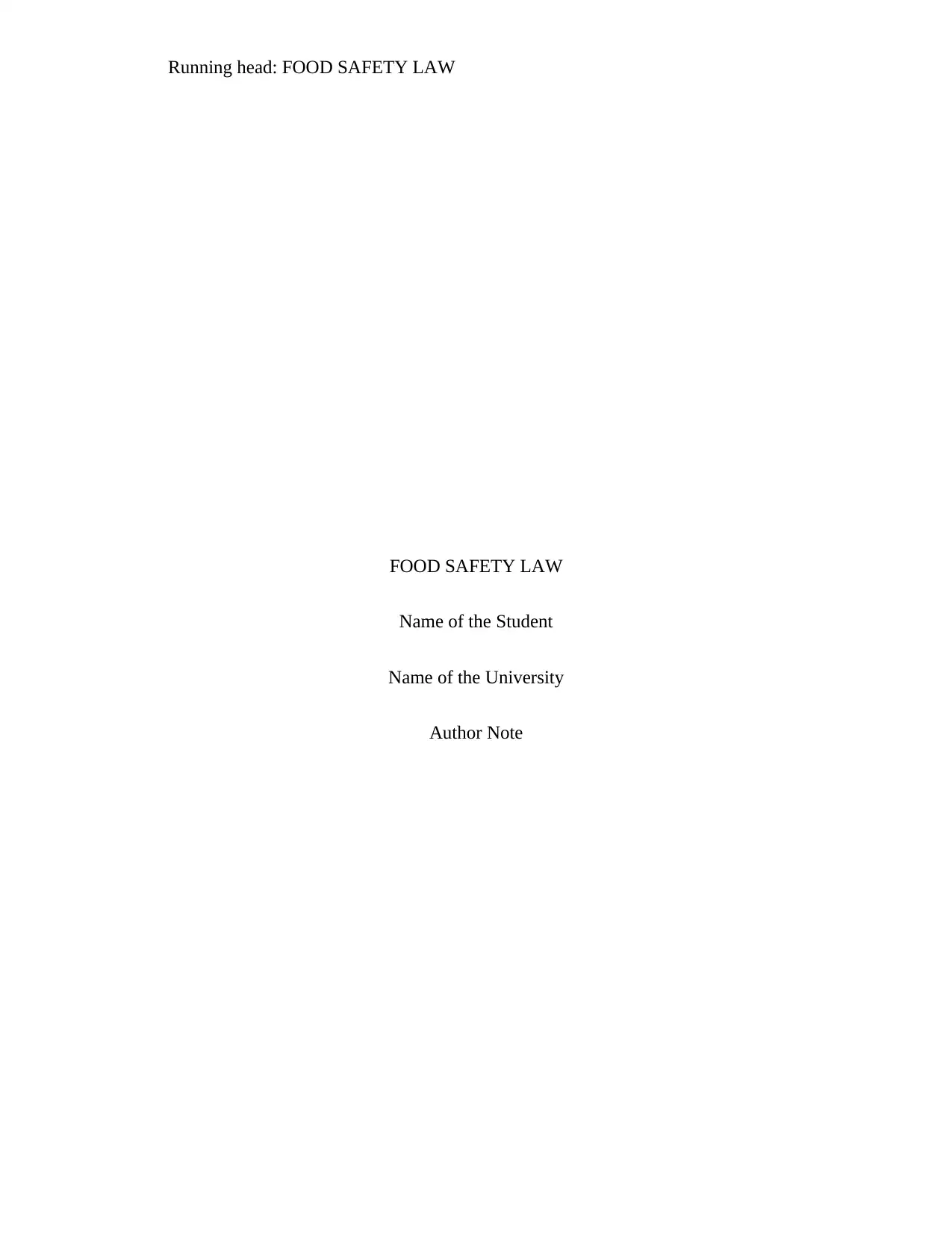
Running head: FOOD SAFETY LAW
FOOD SAFETY LAW
Name of the Student
Name of the University
Author Note
FOOD SAFETY LAW
Name of the Student
Name of the University
Author Note
Paraphrase This Document
Need a fresh take? Get an instant paraphrase of this document with our AI Paraphraser
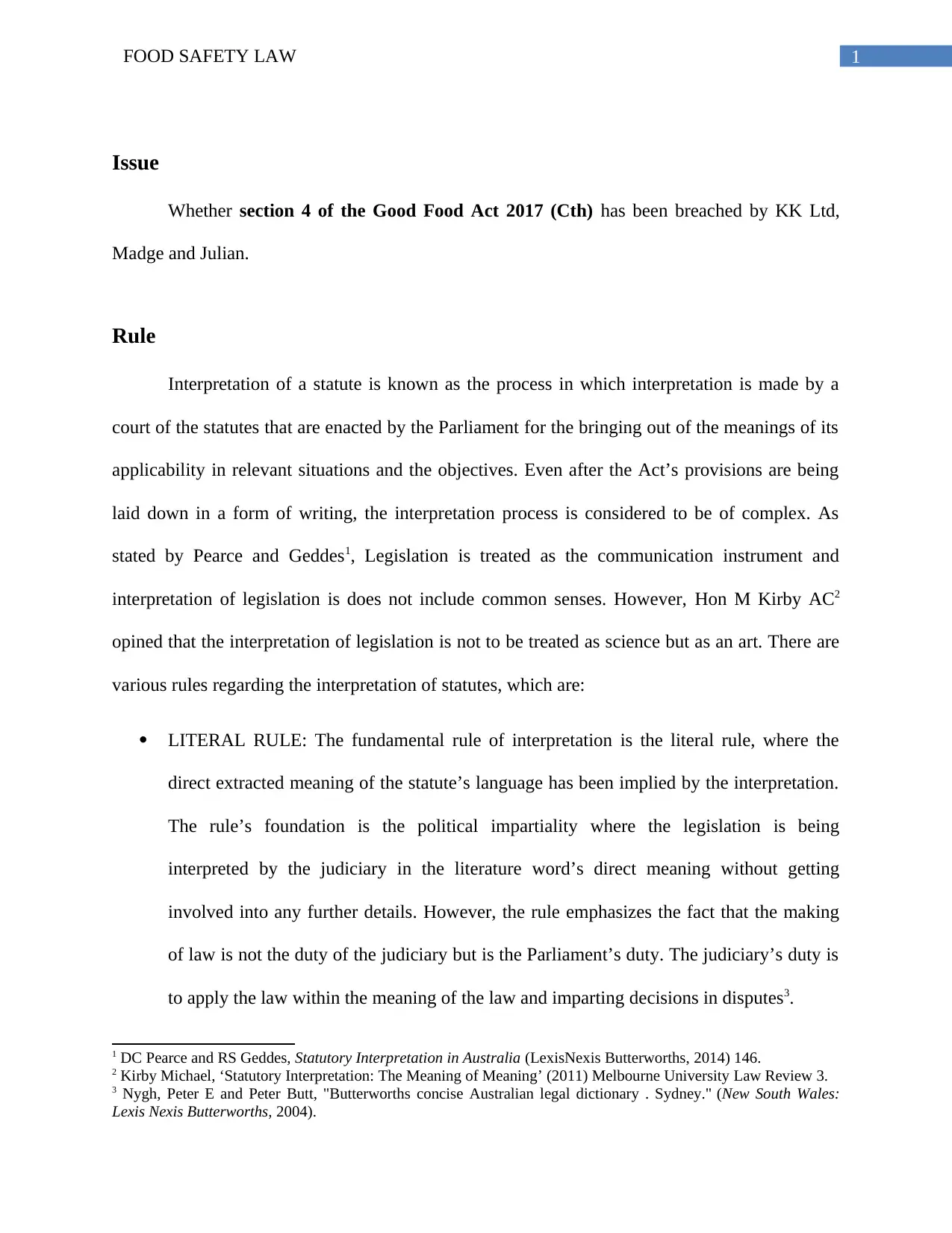
1FOOD SAFETY LAW
Issue
Whether section 4 of the Good Food Act 2017 (Cth) has been breached by KK Ltd,
Madge and Julian.
Rule
Interpretation of a statute is known as the process in which interpretation is made by a
court of the statutes that are enacted by the Parliament for the bringing out of the meanings of its
applicability in relevant situations and the objectives. Even after the Act’s provisions are being
laid down in a form of writing, the interpretation process is considered to be of complex. As
stated by Pearce and Geddes1, Legislation is treated as the communication instrument and
interpretation of legislation is does not include common senses. However, Hon M Kirby AC2
opined that the interpretation of legislation is not to be treated as science but as an art. There are
various rules regarding the interpretation of statutes, which are:
LITERAL RULE: The fundamental rule of interpretation is the literal rule, where the
direct extracted meaning of the statute’s language has been implied by the interpretation.
The rule’s foundation is the political impartiality where the legislation is being
interpreted by the judiciary in the literature word’s direct meaning without getting
involved into any further details. However, the rule emphasizes the fact that the making
of law is not the duty of the judiciary but is the Parliament’s duty. The judiciary’s duty is
to apply the law within the meaning of the law and imparting decisions in disputes3.
1 DC Pearce and RS Geddes, Statutory Interpretation in Australia (LexisNexis Butterworths, 2014) 146.
2 Kirby Michael, ‘Statutory Interpretation: The Meaning of Meaning’ (2011) Melbourne University Law Review 3.
3 Nygh, Peter E and Peter Butt, "Butterworths concise Australian legal dictionary . Sydney." (New South Wales:
Lexis Nexis Butterworths, 2004).
Issue
Whether section 4 of the Good Food Act 2017 (Cth) has been breached by KK Ltd,
Madge and Julian.
Rule
Interpretation of a statute is known as the process in which interpretation is made by a
court of the statutes that are enacted by the Parliament for the bringing out of the meanings of its
applicability in relevant situations and the objectives. Even after the Act’s provisions are being
laid down in a form of writing, the interpretation process is considered to be of complex. As
stated by Pearce and Geddes1, Legislation is treated as the communication instrument and
interpretation of legislation is does not include common senses. However, Hon M Kirby AC2
opined that the interpretation of legislation is not to be treated as science but as an art. There are
various rules regarding the interpretation of statutes, which are:
LITERAL RULE: The fundamental rule of interpretation is the literal rule, where the
direct extracted meaning of the statute’s language has been implied by the interpretation.
The rule’s foundation is the political impartiality where the legislation is being
interpreted by the judiciary in the literature word’s direct meaning without getting
involved into any further details. However, the rule emphasizes the fact that the making
of law is not the duty of the judiciary but is the Parliament’s duty. The judiciary’s duty is
to apply the law within the meaning of the law and imparting decisions in disputes3.
1 DC Pearce and RS Geddes, Statutory Interpretation in Australia (LexisNexis Butterworths, 2014) 146.
2 Kirby Michael, ‘Statutory Interpretation: The Meaning of Meaning’ (2011) Melbourne University Law Review 3.
3 Nygh, Peter E and Peter Butt, "Butterworths concise Australian legal dictionary . Sydney." (New South Wales:
Lexis Nexis Butterworths, 2004).
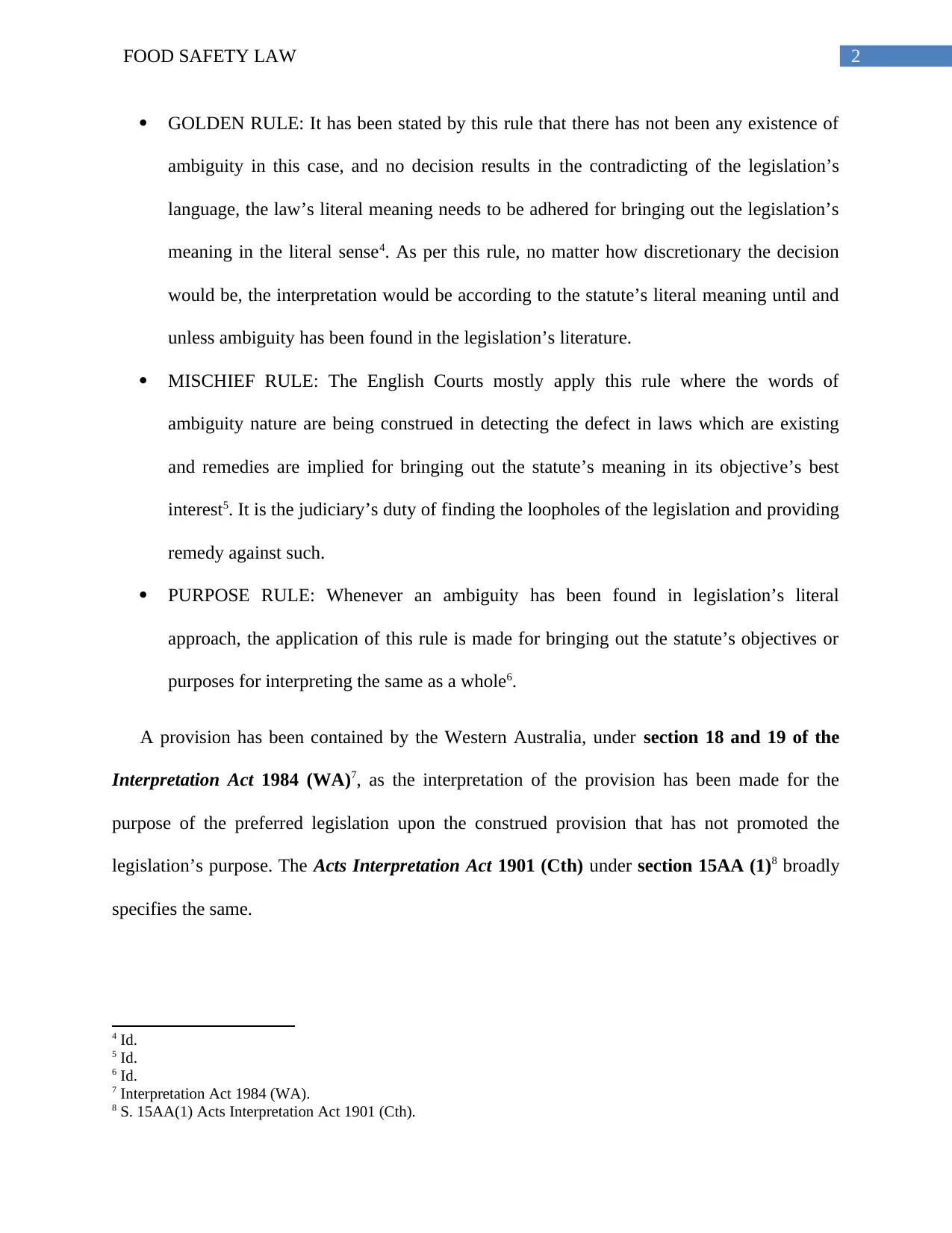
2FOOD SAFETY LAW
GOLDEN RULE: It has been stated by this rule that there has not been any existence of
ambiguity in this case, and no decision results in the contradicting of the legislation’s
language, the law’s literal meaning needs to be adhered for bringing out the legislation’s
meaning in the literal sense4. As per this rule, no matter how discretionary the decision
would be, the interpretation would be according to the statute’s literal meaning until and
unless ambiguity has been found in the legislation’s literature.
MISCHIEF RULE: The English Courts mostly apply this rule where the words of
ambiguity nature are being construed in detecting the defect in laws which are existing
and remedies are implied for bringing out the statute’s meaning in its objective’s best
interest5. It is the judiciary’s duty of finding the loopholes of the legislation and providing
remedy against such.
PURPOSE RULE: Whenever an ambiguity has been found in legislation’s literal
approach, the application of this rule is made for bringing out the statute’s objectives or
purposes for interpreting the same as a whole6.
A provision has been contained by the Western Australia, under section 18 and 19 of the
Interpretation Act 1984 (WA)7, as the interpretation of the provision has been made for the
purpose of the preferred legislation upon the construed provision that has not promoted the
legislation’s purpose. The Acts Interpretation Act 1901 (Cth) under section 15AA (1)8 broadly
specifies the same.
4 Id.
5 Id.
6 Id.
7 Interpretation Act 1984 (WA).
8 S. 15AA(1) Acts Interpretation Act 1901 (Cth).
GOLDEN RULE: It has been stated by this rule that there has not been any existence of
ambiguity in this case, and no decision results in the contradicting of the legislation’s
language, the law’s literal meaning needs to be adhered for bringing out the legislation’s
meaning in the literal sense4. As per this rule, no matter how discretionary the decision
would be, the interpretation would be according to the statute’s literal meaning until and
unless ambiguity has been found in the legislation’s literature.
MISCHIEF RULE: The English Courts mostly apply this rule where the words of
ambiguity nature are being construed in detecting the defect in laws which are existing
and remedies are implied for bringing out the statute’s meaning in its objective’s best
interest5. It is the judiciary’s duty of finding the loopholes of the legislation and providing
remedy against such.
PURPOSE RULE: Whenever an ambiguity has been found in legislation’s literal
approach, the application of this rule is made for bringing out the statute’s objectives or
purposes for interpreting the same as a whole6.
A provision has been contained by the Western Australia, under section 18 and 19 of the
Interpretation Act 1984 (WA)7, as the interpretation of the provision has been made for the
purpose of the preferred legislation upon the construed provision that has not promoted the
legislation’s purpose. The Acts Interpretation Act 1901 (Cth) under section 15AA (1)8 broadly
specifies the same.
4 Id.
5 Id.
6 Id.
7 Interpretation Act 1984 (WA).
8 S. 15AA(1) Acts Interpretation Act 1901 (Cth).
⊘ This is a preview!⊘
Do you want full access?
Subscribe today to unlock all pages.

Trusted by 1+ million students worldwide
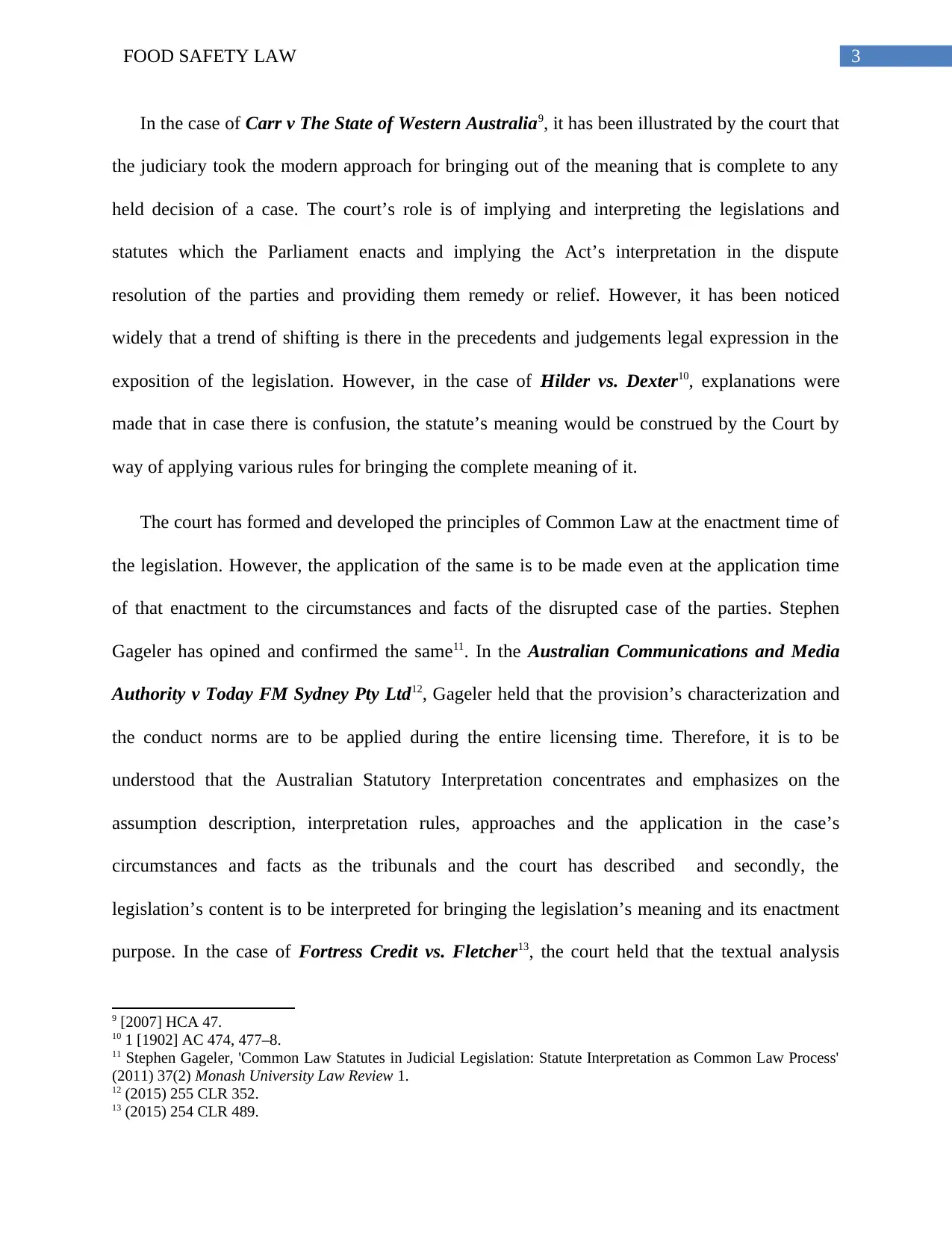
3FOOD SAFETY LAW
In the case of Carr v The State of Western Australia9, it has been illustrated by the court that
the judiciary took the modern approach for bringing out of the meaning that is complete to any
held decision of a case. The court’s role is of implying and interpreting the legislations and
statutes which the Parliament enacts and implying the Act’s interpretation in the dispute
resolution of the parties and providing them remedy or relief. However, it has been noticed
widely that a trend of shifting is there in the precedents and judgements legal expression in the
exposition of the legislation. However, in the case of Hilder vs. Dexter10, explanations were
made that in case there is confusion, the statute’s meaning would be construed by the Court by
way of applying various rules for bringing the complete meaning of it.
The court has formed and developed the principles of Common Law at the enactment time of
the legislation. However, the application of the same is to be made even at the application time
of that enactment to the circumstances and facts of the disrupted case of the parties. Stephen
Gageler has opined and confirmed the same11. In the Australian Communications and Media
Authority v Today FM Sydney Pty Ltd12, Gageler held that the provision’s characterization and
the conduct norms are to be applied during the entire licensing time. Therefore, it is to be
understood that the Australian Statutory Interpretation concentrates and emphasizes on the
assumption description, interpretation rules, approaches and the application in the case’s
circumstances and facts as the tribunals and the court has described and secondly, the
legislation’s content is to be interpreted for bringing the legislation’s meaning and its enactment
purpose. In the case of Fortress Credit vs. Fletcher13, the court held that the textual analysis
9 [2007] HCA 47.
10 1 [1902] AC 474, 477–8.
11 Stephen Gageler, 'Common Law Statutes in Judicial Legislation: Statute Interpretation as Common Law Process'
(2011) 37(2) Monash University Law Review 1.
12 (2015) 255 CLR 352.
13 (2015) 254 CLR 489.
In the case of Carr v The State of Western Australia9, it has been illustrated by the court that
the judiciary took the modern approach for bringing out of the meaning that is complete to any
held decision of a case. The court’s role is of implying and interpreting the legislations and
statutes which the Parliament enacts and implying the Act’s interpretation in the dispute
resolution of the parties and providing them remedy or relief. However, it has been noticed
widely that a trend of shifting is there in the precedents and judgements legal expression in the
exposition of the legislation. However, in the case of Hilder vs. Dexter10, explanations were
made that in case there is confusion, the statute’s meaning would be construed by the Court by
way of applying various rules for bringing the complete meaning of it.
The court has formed and developed the principles of Common Law at the enactment time of
the legislation. However, the application of the same is to be made even at the application time
of that enactment to the circumstances and facts of the disrupted case of the parties. Stephen
Gageler has opined and confirmed the same11. In the Australian Communications and Media
Authority v Today FM Sydney Pty Ltd12, Gageler held that the provision’s characterization and
the conduct norms are to be applied during the entire licensing time. Therefore, it is to be
understood that the Australian Statutory Interpretation concentrates and emphasizes on the
assumption description, interpretation rules, approaches and the application in the case’s
circumstances and facts as the tribunals and the court has described and secondly, the
legislation’s content is to be interpreted for bringing the legislation’s meaning and its enactment
purpose. In the case of Fortress Credit vs. Fletcher13, the court held that the textual analysis
9 [2007] HCA 47.
10 1 [1902] AC 474, 477–8.
11 Stephen Gageler, 'Common Law Statutes in Judicial Legislation: Statute Interpretation as Common Law Process'
(2011) 37(2) Monash University Law Review 1.
12 (2015) 255 CLR 352.
13 (2015) 254 CLR 489.
Paraphrase This Document
Need a fresh take? Get an instant paraphrase of this document with our AI Paraphraser
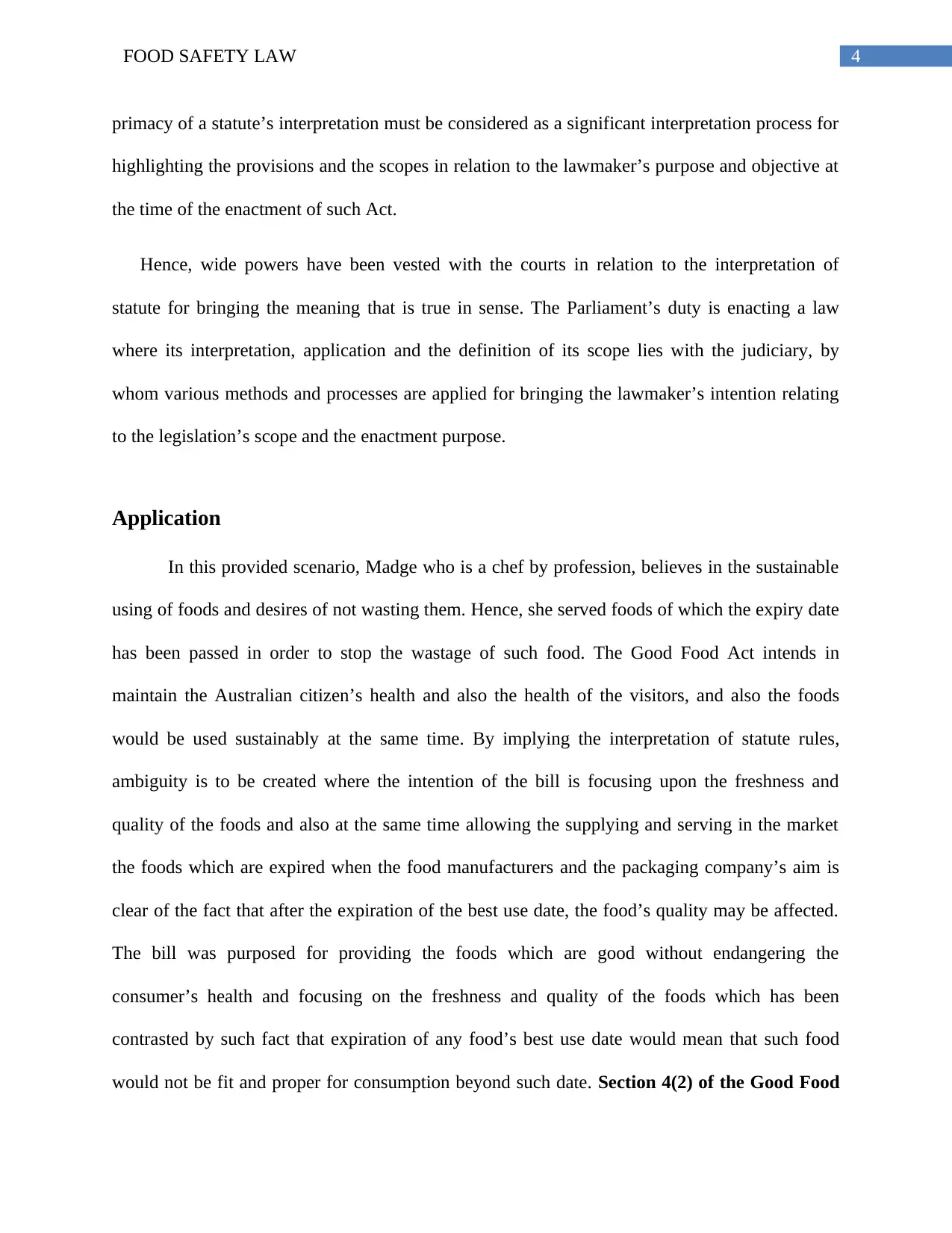
4FOOD SAFETY LAW
primacy of a statute’s interpretation must be considered as a significant interpretation process for
highlighting the provisions and the scopes in relation to the lawmaker’s purpose and objective at
the time of the enactment of such Act.
Hence, wide powers have been vested with the courts in relation to the interpretation of
statute for bringing the meaning that is true in sense. The Parliament’s duty is enacting a law
where its interpretation, application and the definition of its scope lies with the judiciary, by
whom various methods and processes are applied for bringing the lawmaker’s intention relating
to the legislation’s scope and the enactment purpose.
Application
In this provided scenario, Madge who is a chef by profession, believes in the sustainable
using of foods and desires of not wasting them. Hence, she served foods of which the expiry date
has been passed in order to stop the wastage of such food. The Good Food Act intends in
maintain the Australian citizen’s health and also the health of the visitors, and also the foods
would be used sustainably at the same time. By implying the interpretation of statute rules,
ambiguity is to be created where the intention of the bill is focusing upon the freshness and
quality of the foods and also at the same time allowing the supplying and serving in the market
the foods which are expired when the food manufacturers and the packaging company’s aim is
clear of the fact that after the expiration of the best use date, the food’s quality may be affected.
The bill was purposed for providing the foods which are good without endangering the
consumer’s health and focusing on the freshness and quality of the foods which has been
contrasted by such fact that expiration of any food’s best use date would mean that such food
would not be fit and proper for consumption beyond such date. Section 4(2) of the Good Food
primacy of a statute’s interpretation must be considered as a significant interpretation process for
highlighting the provisions and the scopes in relation to the lawmaker’s purpose and objective at
the time of the enactment of such Act.
Hence, wide powers have been vested with the courts in relation to the interpretation of
statute for bringing the meaning that is true in sense. The Parliament’s duty is enacting a law
where its interpretation, application and the definition of its scope lies with the judiciary, by
whom various methods and processes are applied for bringing the lawmaker’s intention relating
to the legislation’s scope and the enactment purpose.
Application
In this provided scenario, Madge who is a chef by profession, believes in the sustainable
using of foods and desires of not wasting them. Hence, she served foods of which the expiry date
has been passed in order to stop the wastage of such food. The Good Food Act intends in
maintain the Australian citizen’s health and also the health of the visitors, and also the foods
would be used sustainably at the same time. By implying the interpretation of statute rules,
ambiguity is to be created where the intention of the bill is focusing upon the freshness and
quality of the foods and also at the same time allowing the supplying and serving in the market
the foods which are expired when the food manufacturers and the packaging company’s aim is
clear of the fact that after the expiration of the best use date, the food’s quality may be affected.
The bill was purposed for providing the foods which are good without endangering the
consumer’s health and focusing on the freshness and quality of the foods which has been
contrasted by such fact that expiration of any food’s best use date would mean that such food
would not be fit and proper for consumption beyond such date. Section 4(2) of the Good Food
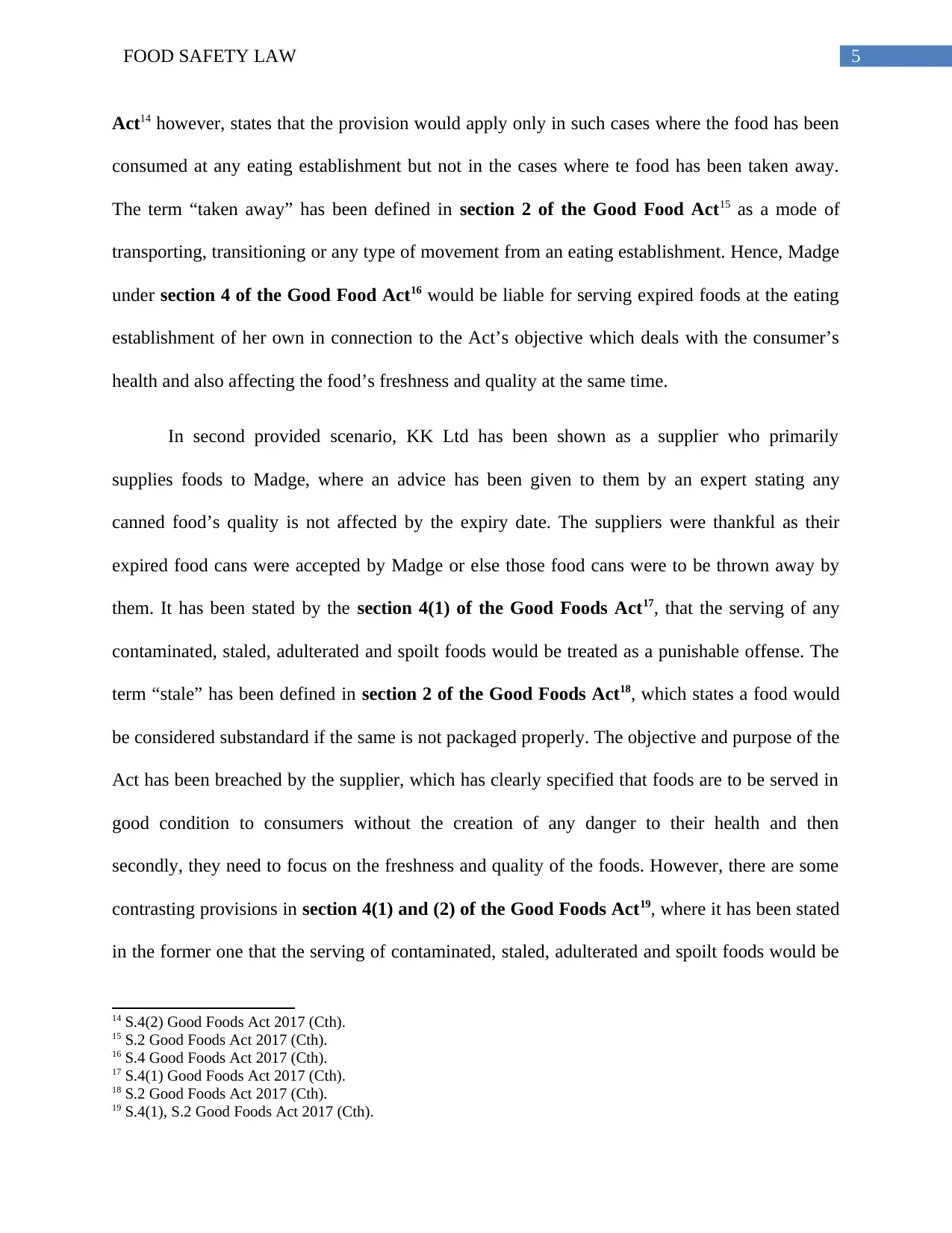
5FOOD SAFETY LAW
Act14 however, states that the provision would apply only in such cases where the food has been
consumed at any eating establishment but not in the cases where te food has been taken away.
The term “taken away” has been defined in section 2 of the Good Food Act15 as a mode of
transporting, transitioning or any type of movement from an eating establishment. Hence, Madge
under section 4 of the Good Food Act16 would be liable for serving expired foods at the eating
establishment of her own in connection to the Act’s objective which deals with the consumer’s
health and also affecting the food’s freshness and quality at the same time.
In second provided scenario, KK Ltd has been shown as a supplier who primarily
supplies foods to Madge, where an advice has been given to them by an expert stating any
canned food’s quality is not affected by the expiry date. The suppliers were thankful as their
expired food cans were accepted by Madge or else those food cans were to be thrown away by
them. It has been stated by the section 4(1) of the Good Foods Act17, that the serving of any
contaminated, staled, adulterated and spoilt foods would be treated as a punishable offense. The
term “stale” has been defined in section 2 of the Good Foods Act18, which states a food would
be considered substandard if the same is not packaged properly. The objective and purpose of the
Act has been breached by the supplier, which has clearly specified that foods are to be served in
good condition to consumers without the creation of any danger to their health and then
secondly, they need to focus on the freshness and quality of the foods. However, there are some
contrasting provisions in section 4(1) and (2) of the Good Foods Act19, where it has been stated
in the former one that the serving of contaminated, staled, adulterated and spoilt foods would be
14 S.4(2) Good Foods Act 2017 (Cth).
15 S.2 Good Foods Act 2017 (Cth).
16 S.4 Good Foods Act 2017 (Cth).
17 S.4(1) Good Foods Act 2017 (Cth).
18 S.2 Good Foods Act 2017 (Cth).
19 S.4(1), S.2 Good Foods Act 2017 (Cth).
Act14 however, states that the provision would apply only in such cases where the food has been
consumed at any eating establishment but not in the cases where te food has been taken away.
The term “taken away” has been defined in section 2 of the Good Food Act15 as a mode of
transporting, transitioning or any type of movement from an eating establishment. Hence, Madge
under section 4 of the Good Food Act16 would be liable for serving expired foods at the eating
establishment of her own in connection to the Act’s objective which deals with the consumer’s
health and also affecting the food’s freshness and quality at the same time.
In second provided scenario, KK Ltd has been shown as a supplier who primarily
supplies foods to Madge, where an advice has been given to them by an expert stating any
canned food’s quality is not affected by the expiry date. The suppliers were thankful as their
expired food cans were accepted by Madge or else those food cans were to be thrown away by
them. It has been stated by the section 4(1) of the Good Foods Act17, that the serving of any
contaminated, staled, adulterated and spoilt foods would be treated as a punishable offense. The
term “stale” has been defined in section 2 of the Good Foods Act18, which states a food would
be considered substandard if the same is not packaged properly. The objective and purpose of the
Act has been breached by the supplier, which has clearly specified that foods are to be served in
good condition to consumers without the creation of any danger to their health and then
secondly, they need to focus on the freshness and quality of the foods. However, there are some
contrasting provisions in section 4(1) and (2) of the Good Foods Act19, where it has been stated
in the former one that the serving of contaminated, staled, adulterated and spoilt foods would be
14 S.4(2) Good Foods Act 2017 (Cth).
15 S.2 Good Foods Act 2017 (Cth).
16 S.4 Good Foods Act 2017 (Cth).
17 S.4(1) Good Foods Act 2017 (Cth).
18 S.2 Good Foods Act 2017 (Cth).
19 S.4(1), S.2 Good Foods Act 2017 (Cth).
⊘ This is a preview!⊘
Do you want full access?
Subscribe today to unlock all pages.

Trusted by 1+ million students worldwide
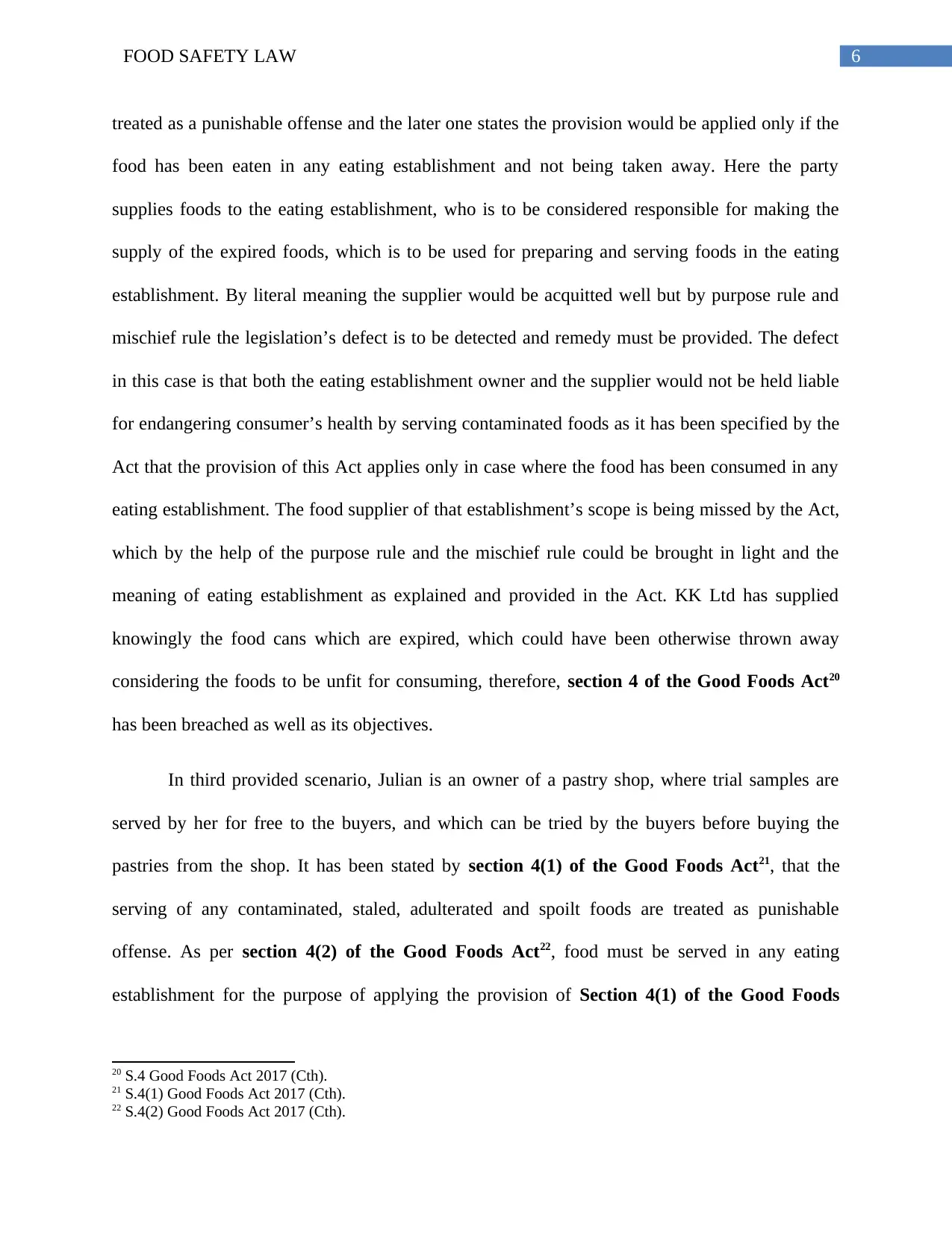
6FOOD SAFETY LAW
treated as a punishable offense and the later one states the provision would be applied only if the
food has been eaten in any eating establishment and not being taken away. Here the party
supplies foods to the eating establishment, who is to be considered responsible for making the
supply of the expired foods, which is to be used for preparing and serving foods in the eating
establishment. By literal meaning the supplier would be acquitted well but by purpose rule and
mischief rule the legislation’s defect is to be detected and remedy must be provided. The defect
in this case is that both the eating establishment owner and the supplier would not be held liable
for endangering consumer’s health by serving contaminated foods as it has been specified by the
Act that the provision of this Act applies only in case where the food has been consumed in any
eating establishment. The food supplier of that establishment’s scope is being missed by the Act,
which by the help of the purpose rule and the mischief rule could be brought in light and the
meaning of eating establishment as explained and provided in the Act. KK Ltd has supplied
knowingly the food cans which are expired, which could have been otherwise thrown away
considering the foods to be unfit for consuming, therefore, section 4 of the Good Foods Act20
has been breached as well as its objectives.
In third provided scenario, Julian is an owner of a pastry shop, where trial samples are
served by her for free to the buyers, and which can be tried by the buyers before buying the
pastries from the shop. It has been stated by section 4(1) of the Good Foods Act21, that the
serving of any contaminated, staled, adulterated and spoilt foods are treated as punishable
offense. As per section 4(2) of the Good Foods Act22, food must be served in any eating
establishment for the purpose of applying the provision of Section 4(1) of the Good Foods
20 S.4 Good Foods Act 2017 (Cth).
21 S.4(1) Good Foods Act 2017 (Cth).
22 S.4(2) Good Foods Act 2017 (Cth).
treated as a punishable offense and the later one states the provision would be applied only if the
food has been eaten in any eating establishment and not being taken away. Here the party
supplies foods to the eating establishment, who is to be considered responsible for making the
supply of the expired foods, which is to be used for preparing and serving foods in the eating
establishment. By literal meaning the supplier would be acquitted well but by purpose rule and
mischief rule the legislation’s defect is to be detected and remedy must be provided. The defect
in this case is that both the eating establishment owner and the supplier would not be held liable
for endangering consumer’s health by serving contaminated foods as it has been specified by the
Act that the provision of this Act applies only in case where the food has been consumed in any
eating establishment. The food supplier of that establishment’s scope is being missed by the Act,
which by the help of the purpose rule and the mischief rule could be brought in light and the
meaning of eating establishment as explained and provided in the Act. KK Ltd has supplied
knowingly the food cans which are expired, which could have been otherwise thrown away
considering the foods to be unfit for consuming, therefore, section 4 of the Good Foods Act20
has been breached as well as its objectives.
In third provided scenario, Julian is an owner of a pastry shop, where trial samples are
served by her for free to the buyers, and which can be tried by the buyers before buying the
pastries from the shop. It has been stated by section 4(1) of the Good Foods Act21, that the
serving of any contaminated, staled, adulterated and spoilt foods are treated as punishable
offense. As per section 4(2) of the Good Foods Act22, food must be served in any eating
establishment for the purpose of applying the provision of Section 4(1) of the Good Foods
20 S.4 Good Foods Act 2017 (Cth).
21 S.4(1) Good Foods Act 2017 (Cth).
22 S.4(2) Good Foods Act 2017 (Cth).
Paraphrase This Document
Need a fresh take? Get an instant paraphrase of this document with our AI Paraphraser
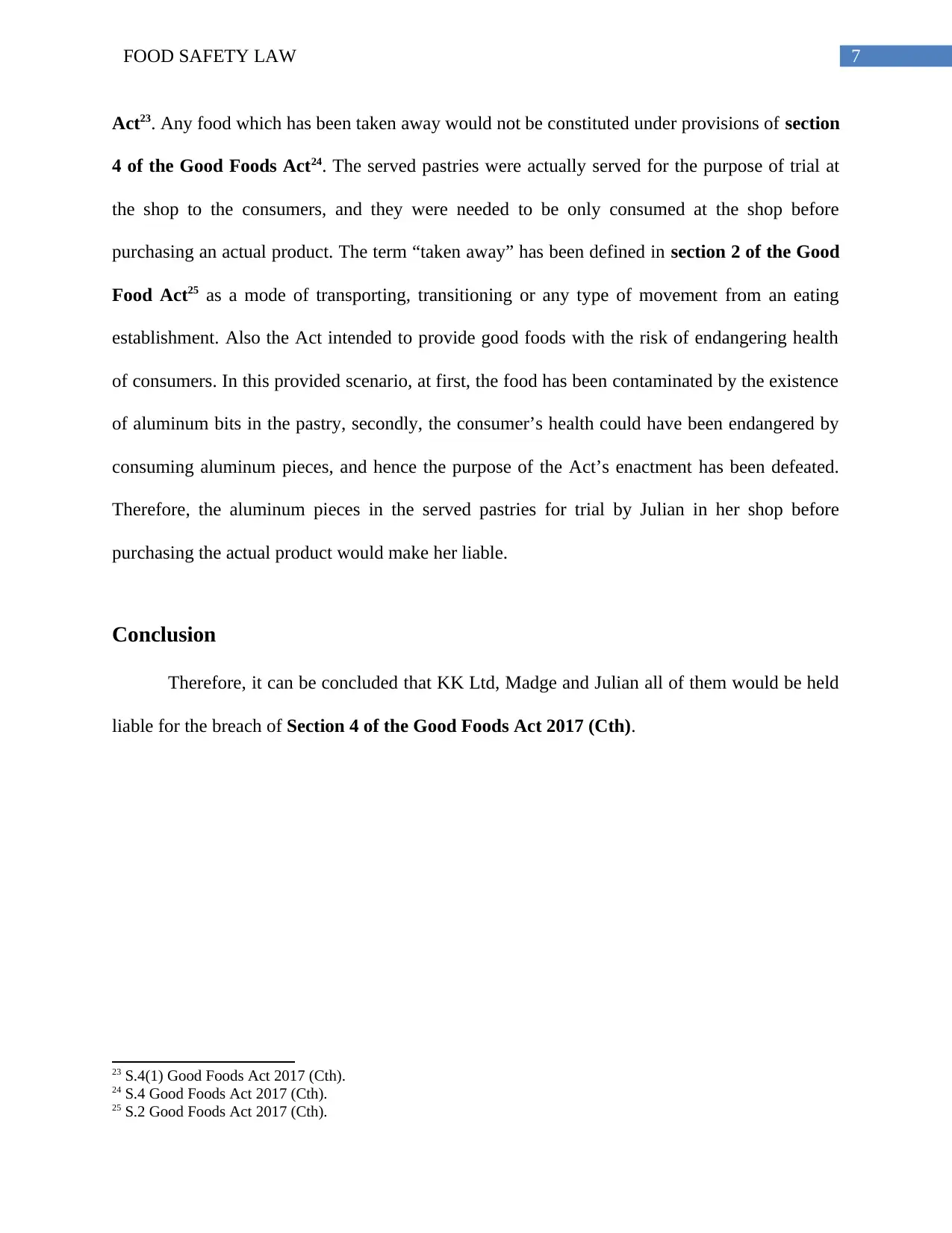
7FOOD SAFETY LAW
Act23. Any food which has been taken away would not be constituted under provisions of section
4 of the Good Foods Act24. The served pastries were actually served for the purpose of trial at
the shop to the consumers, and they were needed to be only consumed at the shop before
purchasing an actual product. The term “taken away” has been defined in section 2 of the Good
Food Act25 as a mode of transporting, transitioning or any type of movement from an eating
establishment. Also the Act intended to provide good foods with the risk of endangering health
of consumers. In this provided scenario, at first, the food has been contaminated by the existence
of aluminum bits in the pastry, secondly, the consumer’s health could have been endangered by
consuming aluminum pieces, and hence the purpose of the Act’s enactment has been defeated.
Therefore, the aluminum pieces in the served pastries for trial by Julian in her shop before
purchasing the actual product would make her liable.
Conclusion
Therefore, it can be concluded that KK Ltd, Madge and Julian all of them would be held
liable for the breach of Section 4 of the Good Foods Act 2017 (Cth).
23 S.4(1) Good Foods Act 2017 (Cth).
24 S.4 Good Foods Act 2017 (Cth).
25 S.2 Good Foods Act 2017 (Cth).
Act23. Any food which has been taken away would not be constituted under provisions of section
4 of the Good Foods Act24. The served pastries were actually served for the purpose of trial at
the shop to the consumers, and they were needed to be only consumed at the shop before
purchasing an actual product. The term “taken away” has been defined in section 2 of the Good
Food Act25 as a mode of transporting, transitioning or any type of movement from an eating
establishment. Also the Act intended to provide good foods with the risk of endangering health
of consumers. In this provided scenario, at first, the food has been contaminated by the existence
of aluminum bits in the pastry, secondly, the consumer’s health could have been endangered by
consuming aluminum pieces, and hence the purpose of the Act’s enactment has been defeated.
Therefore, the aluminum pieces in the served pastries for trial by Julian in her shop before
purchasing the actual product would make her liable.
Conclusion
Therefore, it can be concluded that KK Ltd, Madge and Julian all of them would be held
liable for the breach of Section 4 of the Good Foods Act 2017 (Cth).
23 S.4(1) Good Foods Act 2017 (Cth).
24 S.4 Good Foods Act 2017 (Cth).
25 S.2 Good Foods Act 2017 (Cth).
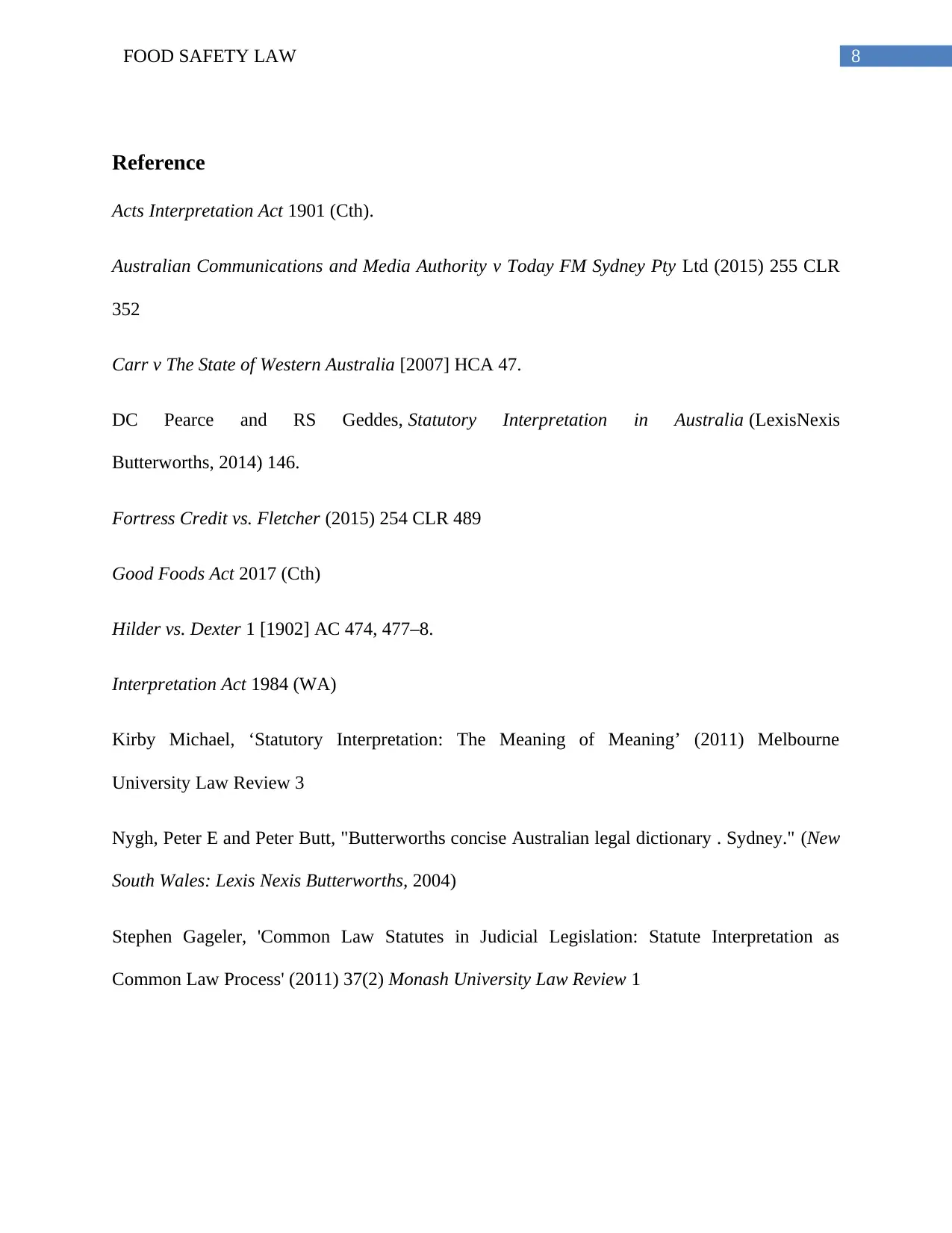
8FOOD SAFETY LAW
Reference
Acts Interpretation Act 1901 (Cth).
Australian Communications and Media Authority v Today FM Sydney Pty Ltd (2015) 255 CLR
352
Carr v The State of Western Australia [2007] HCA 47.
DC Pearce and RS Geddes, Statutory Interpretation in Australia (LexisNexis
Butterworths, 2014) 146.
Fortress Credit vs. Fletcher (2015) 254 CLR 489
Good Foods Act 2017 (Cth)
Hilder vs. Dexter 1 [1902] AC 474, 477–8.
Interpretation Act 1984 (WA)
Kirby Michael, ‘Statutory Interpretation: The Meaning of Meaning’ (2011) Melbourne
University Law Review 3
Nygh, Peter E and Peter Butt, "Butterworths concise Australian legal dictionary . Sydney." (New
South Wales: Lexis Nexis Butterworths, 2004)
Stephen Gageler, 'Common Law Statutes in Judicial Legislation: Statute Interpretation as
Common Law Process' (2011) 37(2) Monash University Law Review 1
Reference
Acts Interpretation Act 1901 (Cth).
Australian Communications and Media Authority v Today FM Sydney Pty Ltd (2015) 255 CLR
352
Carr v The State of Western Australia [2007] HCA 47.
DC Pearce and RS Geddes, Statutory Interpretation in Australia (LexisNexis
Butterworths, 2014) 146.
Fortress Credit vs. Fletcher (2015) 254 CLR 489
Good Foods Act 2017 (Cth)
Hilder vs. Dexter 1 [1902] AC 474, 477–8.
Interpretation Act 1984 (WA)
Kirby Michael, ‘Statutory Interpretation: The Meaning of Meaning’ (2011) Melbourne
University Law Review 3
Nygh, Peter E and Peter Butt, "Butterworths concise Australian legal dictionary . Sydney." (New
South Wales: Lexis Nexis Butterworths, 2004)
Stephen Gageler, 'Common Law Statutes in Judicial Legislation: Statute Interpretation as
Common Law Process' (2011) 37(2) Monash University Law Review 1
⊘ This is a preview!⊘
Do you want full access?
Subscribe today to unlock all pages.

Trusted by 1+ million students worldwide
1 out of 9
Related Documents
Your All-in-One AI-Powered Toolkit for Academic Success.
+13062052269
info@desklib.com
Available 24*7 on WhatsApp / Email
![[object Object]](/_next/static/media/star-bottom.7253800d.svg)
Unlock your academic potential
Copyright © 2020–2025 A2Z Services. All Rights Reserved. Developed and managed by ZUCOL.





